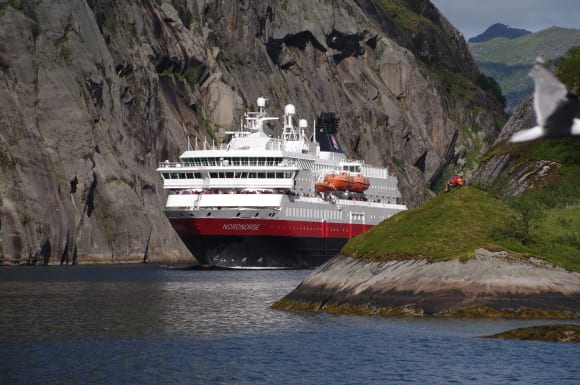Hurtigruten to use dead fish to power cruise ships

Unwanted cutaways from fisheries and other organic waste will soon be used to power Hurtigruten’s fleet of green cruise ships.
In the next step in its quest to become the most environmentally friendly line, the world’s largest expedition cruise operator has announced it will power its ships with liquified biogas (LBG), a fossil-free, renewable fuel produced from organic waste including dead fish.
CEO Daniel Skjeldam said: "What others see as a problem, we see as a resource and a solution.
"By introducing biogas as fuel for cruise ships, Hurtigruten will be the first cruise company to power ships with fossil-free fuel.
"Renewable biogas is a clean source of energy, considered the most eco-friendly fuel currently available.
"Biogas is already used as fuel in small parts of the transport sector, especially in buses.
"Northern Europe and Norway, which has large fishery and forestry sectors that produces a steady volume of organic waste, has a unique opportunity to become world leader in biogas production.
By 2021, Hurtigruten plans to operate at least six of its ships on a combination of biogas, LNG and large battery packs.
"While competitors are running on cheap, polluting heavy fuel oil, our ships will literally be powered by nature, Skjeldam added.
"Biogas is the greenest fuel in shipping, and will be a huge advantage for the environment. We would love other cruise companies to follow."
Hurtigruten has already banned single-use plastic and, next year, will introduce the world’s first battery-hybrid powered cruise ship, MS Roald Amundsen, custom built for sustainable operations in some of the world’s most pristine waters such as Antarctica.
Next year will also see the start of a large-scale green upgrade project, replacing traditional diesel propulsion with battery packs and gas engines on several Hurtigruten ships.
In addition to liquified natural gas (LNG), these ships will also be the first cruise ships in the world to run on liquified biogas (LBG).
Two more hybrid-powered expedition ships Fridtjof Nansen and the as-yet-unnamed sister ship, will be delivered in 2020 and 2021.
The cruise line expects to invest $850 million in building the world’s greenest cruise line.
Lisa
Lisa joined Travel Weekly nearly 25 years ago as technology reporter and then sailed around the world for a couple of years as cruise correspondent, before becoming deputy editor. Now freelance, Lisa writes for various print and web publications, edits Corporate Traveller’s client magazine, Gateway, and works on the acclaimed Remembering Wildlife series of photography books, which raise awareness of nature’s most at-risk species and helps to fund their protection.
 United Kingdom
United Kingdom United States
United States Asia Pacific
Asia Pacific












































Dozens fall ill in P&O Cruises ship outbreak
Boy falls to death on cruise ship
Turkish Airlines flight in emergency landing after pilot dies
Unexpected wave rocks cruise ship
Woman dies after going overboard in English Channel